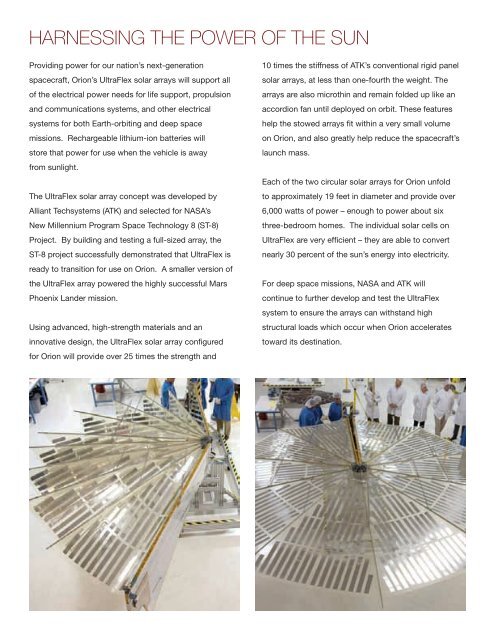Orion: America's Next Generation Spacecraft (4.7 Mb PDF) - NASA
Orion: America's Next Generation Spacecraft (4.7 Mb PDF) - NASA
Orion: America's Next Generation Spacecraft (4.7 Mb PDF) - NASA
Create successful ePaper yourself
Turn your PDF publications into a flip-book with our unique Google optimized e-Paper software.
HARNESSING THE POWER OF THE SUN<br />
Providing power for our nation’s next-generation<br />
spacecraft, <strong>Orion</strong>’s UltraFlex solar arrays will support all<br />
of the electrical power needs for life support, propulsion<br />
and communications systems, and other electrical<br />
systems for both Earth-orbiting and deep space<br />
missions. Rechargeable lithium-ion batteries will<br />
store that power for use when the vehicle is away<br />
from sunlight.<br />
The UltraFlex solar array concept was developed by<br />
Alliant Techsystems (ATK) and selected for <strong>NASA</strong>’s<br />
New Millennium Program Space Technology 8 (ST-8)<br />
Project. By building and testing a full-sized array, the<br />
ST-8 project successfully demonstrated that UltraFlex is<br />
ready to transition for use on <strong>Orion</strong>. A smaller version of<br />
the UltraFlex array powered the highly successful Mars<br />
Phoenix Lander mission.<br />
Using advanced, high-strength materials and an<br />
innovative design, the UltraFlex solar array configured<br />
for <strong>Orion</strong> will provide over 25 times the strength and<br />
10 times the stiffness of ATK’s conventional rigid panel<br />
solar arrays, at less than one-fourth the weight. The<br />
arrays are also microthin and remain folded up like an<br />
accordion fan until deployed on orbit. These features<br />
help the stowed arrays fit within a very small volume<br />
on <strong>Orion</strong>, and also greatly help reduce the spacecraft’s<br />
launch mass.<br />
Each of the two circular solar arrays for <strong>Orion</strong> unfold<br />
to approximately 19 feet in diameter and provide over<br />
6,000 watts of power – enough to power about six<br />
three-bedroom homes. The individual solar cells on<br />
UltraFlex are very efficient – they are able to convert<br />
nearly 30 percent of the sun’s energy into electricity.<br />
For deep space missions, <strong>NASA</strong> and ATK will<br />
continue to further develop and test the UltraFlex<br />
system to ensure the arrays can withstand high<br />
structural loads which occur when <strong>Orion</strong> accelerates<br />
toward its destination.
















